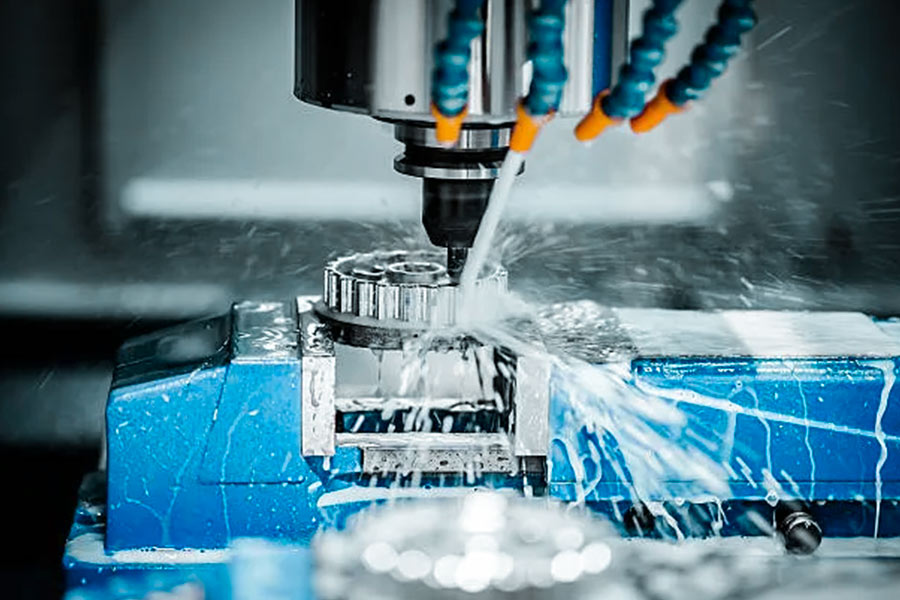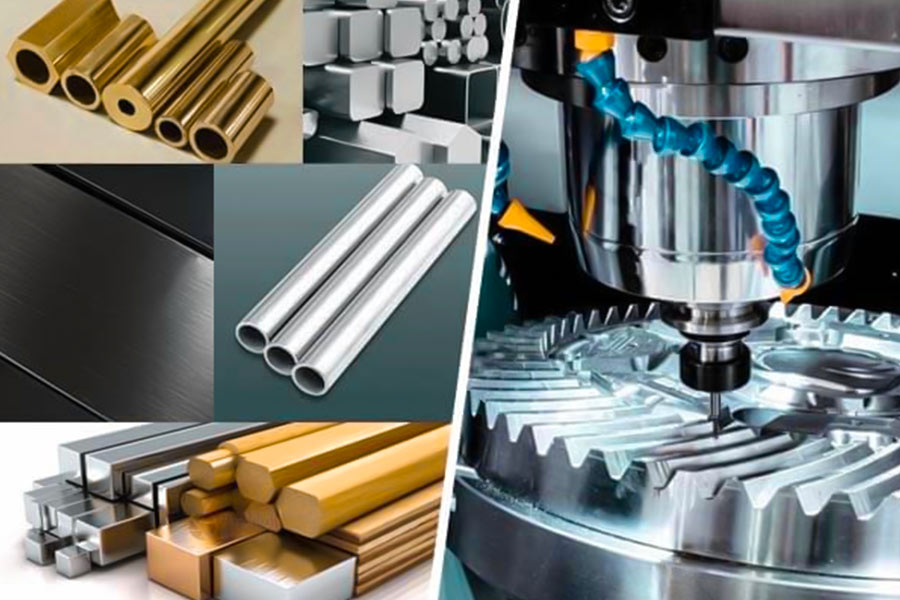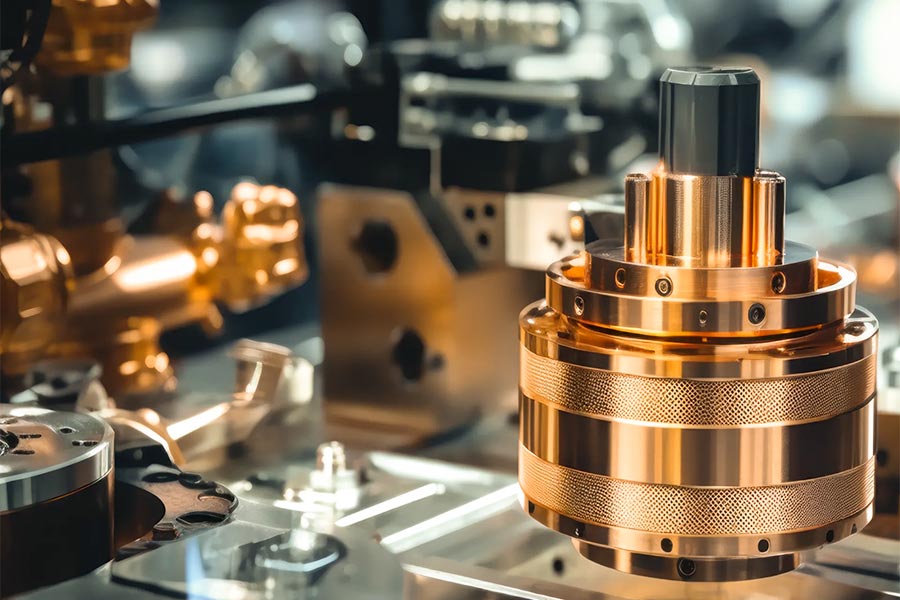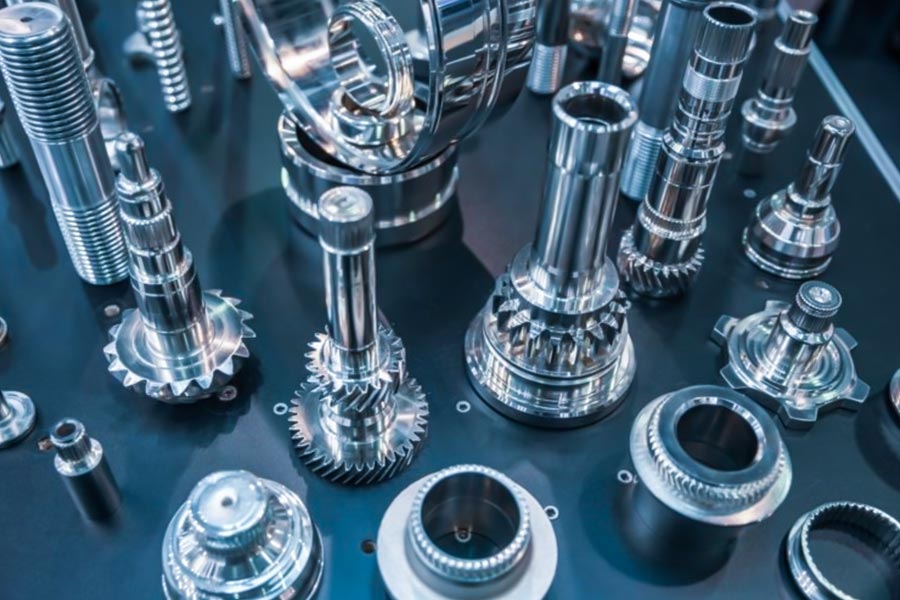No matter how good your design is, it will be useless if you choose the wrong metal
Have you ever wondered whether your design should be made of lightweight aluminum or strong steel? Or, have you ever wondered whether "super materials" like titanium alloy can beCNC machined?
In the world of precision manufacturing,CNC machiningis the powerful engine that transforms digital blueprints into real parts. However, no matter how exquisite your design is, no matter how perfect your 3D model is, all your efforts may be instantly reduced to zero if you choose the wrong metal.
Imagine:a carefully designed part deforms under critical loads due to insufficient material strength; a component that needs to be lightweight is cumbersome due to the selection of metal with too high density; a project that pursues low cost is seriously overspent due to the selection of an alloy that is extremely difficult to process...If you choose the wrong metal, even the best design will be ruined.It directly determines the performance limit, service life, and most importantly, the production cost of your parts.
This is not just a question of "can it be used", but also a question of "how to achieve it optimally". Aluminum, steel, stainless steel, brass, titanium alloy, magnesium alloy, and even some high-temperature alloys... In theory,CNC machinesseem to be able to "bite" a lot of materials. But the key is:
- Which metals are "routine visitors" to CNC machining, with established processes and excellent machinability?
- Which metals, although being machinable, pose severe challenges to tools, parameters, expertise, and have a higher cost?
- Faced with your specific functional requirements, environmental requirements, and cost tolerance, which metal is the "right solution"?
Choosing the best metal is the first important step to understanding your component's success, performance, life, and price.Therefore, let's dispel the fog and peer in detail: Whatmetals are CNC machined? More importantly, what are their respective properties and processing points, and how to make the most logical choice for your next project?
Comparison Table Of Common Metal Material Properties And Applications
| Metal category | Common grades | Core characteristics | Typical application areas |
|---|---|---|---|
| Aluminum alloy | 6061, 7075, 2024, 5052 | Lightweight, high strength-to-weight ratio, easy processing, good electrical/thermal conductivity, corrosion resistance (some grades) | Aerospace (fuselage, frame), consumer electronics (housing, radiator), automobile (wheel hub, components), shipbuilding, building structure, prototyping, sports equipment |
| Steel alloy | 1018, 4140, 1045, 4340, A36 | High strength, high hardness, wear resistance, excellent machinability, good toughness, cost-effective | Molds, gears, shafts, bolts/fasteners, structural parts (buildings, bridges, mechanical frames), tools |
| Stainless steel | 304, 316, 17-4PH, 430, 410 | Excellent corrosion resistance, hygiene, aesthetics, certain strength, high temperature resistance (some grades) | Medical equipment (surgical instruments, implants), food industry (equipment, containers, pipes), chemical equipment, marine hardware, architectural decoration, kitchen utensils, valves/pumps |
| Special alloys | Titanium alloy (Ti-6Al-4V), Inconel 625, 718, Hastelloy C276, Monel alloy (Monel 400) | Extremely high strength, excellent high temperature resistance, extreme corrosion resistance, biocompatibility (titanium alloy), low density (titanium alloy) | Aircraft engine turbine blades/components, spacecraft structures, medical implants (titanium alloy), chemical/petrochemical extreme environment equipment (reactors, pipes), marine engineering, high-performance racing car parts, nuclear industry |
This is a step-by-step guide that will take you through the vast group of metals that can bemachined by CNC, from the most productive to the most exotic. We'll explain their characteristics, draw parallels in how to choose, and present an example that shows how material selection directly affects the final cost ofCNC milling.
Here’s What You’ll Learn:
- A comprehensive analysis of the four main metals:Get an in-depth understanding of the core characteristics, processing advantages and typical application scenarios of aluminum, steel, stainless steel and brass (the key to covering 80% of processing needs).
- A guide to high-performance alloys that conquer extreme challenges:Uncover the value of titanium, copper, and nickel-based alloys (such as Inconel) in aerospace, medical and other fields, and why they are called "machinists' nightmares."
- CNC machining forbidden areas:Identify which metal materials (such as hardened steel, tungsten carbide, and beryllium) cannot or are extremely difficult toCNC process, and understand the key limiting factors behind them.
- Practical decision-making from prototype to mass production:Through real drone bracket cases, learn how to upgrade from aluminum alloy 6061 to 7075 based on test results (such as vibration fatigue) to balance cost and performance.
- Beyond metal processing possibilities:Explore the application potential and special requirements of CNC on engineering plastics (such as PEEK), wood and composite materials (such as carbon fiber).
- Four-step scientific material selection method:Follow the framework of "performance > weight > cost > expert consultation" to quickly lock in the best metal for your project and avoid catastrophic choices.
- Authoritative FAQ hits the pain point directly:Answers to high-frequency questions such as "What is the easiest metal to process?", "How does machinability affect cost?", "Should I choose 6061 or other for my design?".
Now, let's unveil the mystery ofmetal CNC machiningand find the perfect matching material cornerstone for your project!
Why Trust Our Analysis? We Cut These Metals Every Day
Hi, I’m Gloria, an engineer at LS. Customers often ask, “Why should I trust your material analysis?” The answer is simple:this analysis comes from our real cutting every day.
In the LS workshop, it’s not just talk. I, the engineering team and themachinists “compete” withaluminum, steel, titanium, copper and other metals day after day.This kind of daily interaction makes us deeply understand the “temperament” of each material:
- Which kind of aluminum will stick to the tool when cutting at high speed?
- Will this stainless steel break when feeding too fast?
- Why is titanium alloy difficult to process and so picky about coolant?
- What is the key point to make copper parts have a perfect mirror surface?
These answers are engraved in our tool wear records and processing parameters, which are the true knowledge gained from actual combat.
So, when you consult CNC machining metal material selection,you will not only get a "yes/no" answer, but also an engineering suggestion that integrates three elements:
- Thousands of hours of practical experience:We have personally handled the performance of materials in real processing.
- In-depth understanding of your application:What are the specific working conditions and requirements of your parts?
- Pragmatic consideration of your budget:How to find the best cost-effective solution while meeting core needs.
Our analysis is "milled" with machine tools and "ground" with sweat.We understand the "language" of metal and the key to the success of your project. Choosing LS, you get the real experience and professional judgment accumulated by the entire workshop.
The "Four Heavenly Kings" of CNC Machining: Aluminum, Steel, Stainless Steel and Brass
In the vast world of manufacturing,computer numerical control (CNC) machininghas become the cornerstone of modern manufacturing with its high precision, high efficiency and high flexibility. Among the many materials processed by CNC machining, four metals stand out with their excellent comprehensive performance and wide application fields, and are known asthe "Four Heavenly Kings" - they are aluminum alloy, carbon steel/alloy steel, stainless steel and brass.These four types of metals cover almost more than 80% of CNC machining needs and are the absolute main force supporting countless industrial products and daily necessities. Below we will analyze their characteristics and common applications one by one.
1. Aluminum alloy
Characteristics overview:Aluminum alloy is known for its light weight (low density) and excellent thermal and electrical conductivity. It performs particularly well in CNC machining, with excellent machinability, low cutting resistance, low tool wear, high machining efficiency and good surface finish. In addition, a dense oxide film will naturally form on the surface of aluminum alloy, providing good natural corrosion resistance (especially after anodizing).
Common applications:
- Rapid prototyping:The first choice forprototypingthat is sensitive to processing speed and cost.
- Aerospace components:Aircraft structural parts, engine parts, interior parts, etc., fully utilizing their advantages of lightness and strength.
- Automotive parts:Engine blocks, gearbox housings, wheels, chassis parts, radiators, etc., pursuing lightness to improve fuel efficiency.
- Electrical equipment casings:Laptops, mobile phones, tablets, camera bodies, etc., require to be lightweight, possess good heat conductivity, fine appearance and simplicity in processing of intricate shapes.
- Others:Domestic product casings, parts of lighting, robot structural parts, etc.
2. Carbon steel and alloy steel
Characteristics overview:Steel is a perfect material with high hardness and strength, especiallyalloy steel, which can further improve these characteristics by heat treatment. It also has good wear resistance and is able to withstand high loads and impacts. Cost-effectively, steel is a highly economical structure material relative to its performance. It is not as machinable as aluminum and brass but requires more cutting power, tool wear is relatively fast, and easy to rust (usually has to be treated on the surface such as electroplating, spraying, blackening, etc.).
Common applications:
- Mechanical components:principal structural parts such as gears, shafts, bearing seats, racks, connectors, etc.
- Molds:injection molds, stamping molds, die-casting molds (generally constructed of high-hardness alloy mold steel).
- Fixtures:auxiliary machines for production such as tooling fixtures and positioning blocks that require high rigidity and durability.
- Heavy equipment parts:transmission parts, hydraulic parts, and wear-resistant parts of engineering equipment and agricultural equipment.
- Others:tools (wrenches, pliers), fasteners, structural frames, etc.
3. Stainless steel
Characteristics overview:Its chief advantage is the excellent corrosion resistance, based on the passivation coating formed by the chromium component (usually >10.5%) present in it. It also has high toughness and a degree of strength. Stainless steel is easy to disinfect and clean, and can provide a beautiful and durable surface (e.g., mirror and brushed effects). Direct answer: Of course,stainless steelcan be CNC machined! Although its machinability is worse than carbon steel and aluminum (higher cutting force, apparent tendency for work hardening, low thermal conductivity, easy tendency to heat the tool up), with proper grade choice (e.g., 303, 304, 416 and other easy-to-machine stainless steel), tool (carbide, coated tool), cutting parameters and coolant, efficient and high-quality CNC processing can be achieved.
Common applications:
- Medical equipment:surgical instruments, implants (with a specific medical grade defined), equipment encasements, brackets, etc., must be sterility and corrosion resistant against disinfectants.
- Food processing equipment:pump casings, valve parts, agitators, containers, conveyor belt components, etc., must have food hygiene and safety specifications.
- Chemical pipes and fittings:reactors, pipes, fittings, etc., must be resistant to corrosion against chemical media.
- Marine engineering components:marine fittings, offshore platform components, etc., experience long-time high salt fog and humid environments.
- Others:high-quality cookware, bathroom appliances, architectural ornamental pieces, car exhaust pipes, etc.
4. Brass
Characteristics overview:Brass is globally renowned worldwide in CNC machining and is generally viewed as one among the "easiest metals to machine.". It is of low cutting resistance, high speed in machining, long tool life, and can generate excellent surface finish and dimensional accuracy. It also has excellent electrical and thermal conductivity. It is extremely good in sliding or rotational contact applications because of low coefficient of friction. It has good corrosion resistance (excellent compared tocarbon steelbut less good than stainless steel).
Common applications:
- Electrical connectors:Relay components, switch contacts, plugs, terminal blocks, etc., which benefit from their good conductivity and ease of machining to facilitate intricate shapes.
- Valves and pipe fittings:Pipe joints, valve cores, water pipe joints, faucets, etc., exploit their ease of machining and low friction and good sealing.
- Pipe fittings:Various pipe connectors with the requirement for good mechanical properties and corrosion resistance.
- Musical instruments:Wind instruments (trumpets, saxophones), decorative components, etc., with excellent machining and good appearance.
- Others:decorative components, watch components, locks, low-friction bearing bushings, etc.
The so-called "four kings" of aluminum alloy, carbon steel/alloy steel, stainless steel and brasshave solidly taken the mainstream position ofCNC machined materialswith their own special physical, mechanical and chemical properties, relatively outstanding machinability or special application value. From consumer electronics that aim for lightness and rapid prototyping to heavy machines that require ultra-high strength; from chemical medical treatments that withstand harsh corrosive environments to electric and hydraulic systems requiring accuracy and low friction, the four classes of metals provide a robust and versatile material basis for modern manufacturing.Understanding their properties and choosing the right materials is the important first step towardssuccessful CNC machining.

High Performance Areas: Titanium, Copper And Other Special Alloys
When standard materials fail in the face of extreme performance requirements, it is time for "elite metals" such astitanium, copper and nickel-based special alloys such as chromium-nickel-inconel to shine. They each have unique top properties and undertake key missions in demanding fields.
1. Titanium alloy: lightweight strength champion
- Features:It has the highest strength-to-weight ratio of all engineering metals, giving it excellent lightweight performance; it also has amazing corrosion resistance and can resist the erosion of seawater and chemicals; excellent biocompatibility enables it to coexist harmoniously with human tissue.
- Challenges:The processing process is extremely difficult, and the high strength and low thermal conductivity of the material lead to extremely severe tool wear, coupled with high raw material and production costs.
- Applications: It is widely used in the manufacture of medical implants (such as artificial joints, dental implants), key components of aircraft engines (compressor discs, blades) and racing car parts that pursue extreme performance.
2. Copper: Excellent conductor of energy transfer
- Features:Electrical conductivity and thermal conductivity are at the top level among metal materials, making it an ideal carrier for efficient energy transfer.
- Challenge:The texture is relatively soft and sticky, and it is easy to produce built-up edge (sticking tool) during machining, affecting machining efficiency and surface finish.
- Application:It is the core material for manufacturing high-efficiency heat sinks (CPU/GPU heat dissipation), high-current busbars, and electrodes forweldingandEDM.

3. Nickel-based alloys such as chromium-nickel-inconel alloys: Guardians of high-temperature environments
- Features:In the extremely high temperature environments faced by jet engine combustion chambers and gas turbines, it can still maintain excellent structural strength and excellent anti-oxidation and anti-corrosion capabilities.
- Challenge:It is extremely difficult to process. Its high strength, high work hardening tendency and low thermal conductivity lead to huge cutting forces and extremely short tool life. It is called "a mechanic's nightmare" by the industry.
- Application:It is an indispensable material for manufacturing jet engine hot end components (turbine disks, blades), key components of heavy gas turbines, and core high-temperature components of nuclear reactors.
Titanium alloywith its light weight and high strength, copper with its top-notch electrical and thermal conductivity, and nickel-based alloy with its extraordinary heat resistance together constitute the core strength of "elite metals" that break through the boundaries of extreme performance.
What Materials Cannot (Or Are Extremely Difficult to) CNC Machine?
Although CNC machining is powerful, it is not omnipotent. Some materials are extremely hard, highly abrasive or seriously harmful,which makes CNC machine tools helpless and become "forbidden areas" in the field of machining.
1. Extremely hard metals: when the tool meets "hard bones"
- Examples:quenched and hardened tool steel (hardness exceeds HRC 65), tungsten carbide (integral or as a substrate).
- Reason:The hardness of these materials exceeds or even far exceeds the tolerance limit of standard carbide or high-speed steel tools. The tool cannot effectively "gnaw" the material, and at the least, it will be rapidly blunted due to severe wear, and at the worst, it will cause catastrophic chipping or fracture, and it will not be able to cut effectively at all. Processing such materials usually requires special processes such as electrospark machining (EDM).
2. Extremely abrasive materials: invisible "sandpaper"
- Examples:Certain metal matrix composites (MMCs), especially those containing a high proportion of high-hardness reinforcing particles (such as silicon carbide and aluminum oxide particles).
- Reason:The hard and sharp particles in the material are like countless tiny "sandpapers", which continuously scrape and wear the cutting edge of the tool during the processing. This wear rate is extremely alarming, resulting in extremely short tool life and frequent replacement. This not only has extremely low processing efficiency, but also brings extremely high tool and processing costs, which often outweighs the gains.
3. Materials with serious safety hazards: "invisible poison blades"
- Examples:Beryllium alloys (beryllium dust and smoke are very toxic and can cause chronic beryllium disease, a serious and sometimes fatal lung condition).
- Cause:Dry cutting or incorrect application of coolants when processing using CNC will inevitably cause dust, smoke or splashes. Treatment of extremely toxic materials such as beryllium requires extremely stringent and professional protective measures of safety: completely sealed treatment condition, negative pressure air suction, effective air filtering system, operators in positive pressure protective dress with independent oxygen supply, and strict decontamination. The common machining workshops never have these conditions, and mandatory processing will lead to catastrophic health and environmental disasters.
Thus, in the materials world, there isn't really a "master key" - the material's inherent characteristics (hardness, abrasiveness, toxicity) directly influence whether CNC machining can be done or will be economically feasible, and knowledge of these limitations is an essential pre-requisite for effective and safe manufacturing.

Case Summary: Optimization And Upgrade Of Drone Camera Gimbal Bracket Materials
- Customer background:A new survey drone startup business urgently needs a highly durable and light camera gimbal bracket solution.
- Project challenge:Preserve the long-term durability and structural integrity of the bracket within harsh vibration environments while keeping it light.
- LS solution and project history
Phase 1: Rapid prototyping and design verification (with 6061 aluminum alloy)
- Material basis of selection:To support customers' rapid iteration design verification, we recommended 6061 aluminum alloy. This material has excellent all-around overall comprehensive mechanical properties, high quality machinability and cost-effective performance.
- LS service:According to our company's rapid onlineCNC milling service,the customer's design drawings were converted into realistic prototypes within a very short time.
- Test feedback:The prototype duly confirmed the fundamental design functions, but when performing the severe vibration test carried out by the customer, it was discovered that the bracket exhibited minute fatigue fracture symptoms, which exposed long-term reliability threats.
Phase 2: Upgrade of production material and performance (leveling up to 7075 aluminum alloy)
- LS Engineering Recommendation:Based on the test results, our engineers recommended to the customer after thorough analysis: replace the major material of the bracket from 6061 aluminum alloy to 7075 aluminum alloy. Though its unit cost is also greater and the processing difficulty has also risen a bit, with the single-pieceCNC milling costing30% more, its ultimate tensile strength and fatigue strength are roughly double that of 6061, capable of basically eradicating the risk of fracture in a vibration state.
- Customer decision and result:The customer adopted our professional suggestions. The final mass-produced bracket significantly improved the structural stiffness and fatigue life while maintaining excellent lightweight characteristics. The product successfully completed all rigorous certification tests, delivering excellent reliability and flight safety. Such key material upgrade choice successfully avoided potential product quality risks and market recall risks.
- Core value reflection:This project shows how theLS engineering teammore clearly sees customer needs (rapid prototyping vs. mass production reliability). Through professional material selection analysis and quick manufacturing services (online CNC), not only can it help customers validate designs in time, but also optimize solutions at key nodes, and ultimately supply core components with rigorous performance standards and competitive market positioning, for ensuring customer product launch success and brand reputation.
Not Just Metal: What Else Can CNC Machine Other Than Metals?
Although CNC machining is traditionally associated with metal, its application goes far beyond. As a "material sculptor," it has also made great leaps in engineering plastics, wood and composite materials, pushing the boundaries of design and manufacturing greatly.
1. Engineering plastics: Shaping high-performance parts
(1) Representative materials:ABS(tough, easy to process),POM/Delrin (low friction, high rigidity),Nylon(wear-resistant, impact-resistant), PEEK (extreme temperature resistance, chemical resistance, high strength), PC (transparent, high impact resistance).
(2) Application stage:
- Precision functional parts:gears, bearings, bushings, cams (taking advantage of their self-lubrication and wear resistance).
- Electrical safety guards:insulators, connectors, switch housings.Protection and aesthetics: electronic product housings, instrument panels, complex pipe joints, custom fixtures.
(3) CNC advantages:It can process thin-walled complicated geometric shapes with high precision and goodsurface finish, suitable for prototype or small-series production.
2. Wood: From utilitarian to artistic
(1) Processing materials:hardwood (oak, walnut, maple - hard and heavy), softwood (pine, fir - easily worked), artificial board (plywood - stable, MDF - uniform and easy to gouge).
(2) Application stage
- Function and structure:custom furniture components, cabinets, door and window components, musical instrument components.
- Creative expression:fine detail carving, relief, ornamented inlays, signs.
- Models and prototypes:scale models of buildings, product design models (rapid and relatively inexpensive).
(3) CNC advantages:Is able to perform high-speed cutting, fine detail contour carving, grooving,drilling, etc., much more efficiently than conventional woodworking, extremely high repetition accuracy, and is best at complex surfaces and patterns.
3. Composite materials: Leveraging the "buildings materials of the future"
(1) Representative materials:Carbon fiber reinforced polymer (CFRP), glass fiber reinforced polymer (GFRP) (regularly worked in prepreg or laminate state).
(2) Special challenges:
- Tool "rival":Fibers (especially carbon fiber) are extremely hard and abrasive. Special tools (e.g., diamond-coated or polycrystalline diamond PCD tools) and high-speed methods are required, otherwise they will deteriorate very quickly.
- Dust "killer":The microscopic fiber dust generated while cutting (carbon fiber dust is conductive) is extremely harmful to equipment and health. Thorough vacuuming, sealed processing rooms or wet processing are needed safety measures.Delamination and burrs: Inappropriate cutting parameters or tool choice are easily capable of causing material delamination, tearing or difficult-to-handle burrs.
(3) Application stage:Aerospace structure parts (wings, fuselage panels), light weight racing car bodies/parts, drone chassis, high-performance bicycle chassis, racing boat components, tennis racquets, golf clubs and other applications requiring ultimate strength-to-weight ratio.
(4) CNC advantages:It is an essential technology to fabricate composite parts with complicated geometry, high-precision holes and profiles (especially finishing after near-net shaping).
TheCNC machine toolscan be seen as a platform for manufacturing that transcends material types.As long as appropriate tools and parameters are selected and special issues brought about by the materials (e.g., wear and dust) are resolved,it can properly shape infinite possibilities ranging from ordinary plastic parts to sophisticated carbon fiber parts in the international community beyond metal.
How To Choose The Right Metal For Your Project?
The wrong metal is expensive; the right metal is more effective. With all the many metals out there, how do you know which one to choose for your project? By using these four key steps, you will be making smarter, more effective decisions:
1. Performance specifications are paramount: What does your part have to do?
- Strength vs. rigidity:Against what load does it have to resist? Will it be subjected to impact or fatigue loading? How resilient must it be? (e.g., structure vs. cosmetic parts)
- Corrosion resistance:Where is the part going to be employed? Humidity? Chemical environment? Saltwater? Outside? (e.g., ship equipment vs. office equipment)
- Operating temperature:Is it room temperature, high temperature (heat/creep resistance required), or low temperature (toughness required)? (e.g., engine parts vs. refrigerator units)
- Conductivity:Does it need good electrical or thermal conductivity? (e.g., electrical connector vs. heat sink)
- Wear resistance:Is the surface subject to wet friction or wear? (e.g., bearing sleeve vs. housing)
- Special requirements:Do you need non-magnetic properties, biocompatibility, appearance requirements (e.g., polished), etc.?
2. Weight considerations: Light weight or stable?
- Lightweighting first:For parts that need to move or are weight-critical (e.g., aerospace, automotive, handheld), high specific-strength materials (strength/density) are needed (e.g., aluminum alloys, titanium alloys, magnesium alloys).
- Weight benefits:For bases, fixtures, and counterweights that need inertia, stability, or vibration damping, higher-density materials (e.g., carbon steel, cast iron) may be a less expensive or better solution.
3. Cost and budget balance: economics of performance
- Too much performance emphasis:Do you possess a good budget and emphasize meeting the most demanding technical requirements? High-performance alloys (high-temperature nickel alloys, specialty stainless steels, titanium alloys) are the first choice, although they cost more.
- Cost effectiveness first:Do you need to tightly manage costs in order to perform minimum functions? The standard materials such as carbon steel, typical aluminum alloys, and cast iron are usually more cost-effective choices.
- Total Cost of Ownership:Don't just consider the unit cost of the material! Ease of processing, rate of production, life of service, maintenance costs, and scrap value all enter into the job's overall economic viability. Sometimes a costly material is cheaper because it lasts longer or is easier to process.
4. Consult an expert: Let experience be your guide
- The advantage of professional expertise:Metal choice is complex material science, processing technology, and hands-on experience with the reality of practical usage. Book learning sometimes cannot account for all real-world variables.
- LS is your trusted partner:Send us your precise drawings of the design, performance targets, budget constraints, and expected application environment! We possess long experience and know-how to:
- Interpret your needs:Accurately interpret the key needs of the project.
- Evaluate material substitutes:Screen the optimum performing candidate materials from various factors such as performance, weight, cost, and machinability.
- Balance pros and cons:Help you compare the pros and cons of every material substitute in terms of performance, cost, and delivery cycle.
- Balance best:Maximize cost-effectiveness with technical specification compliance, and recommend themetal materialsand potential processing recommendations that best serve your total project requirements.
Selecting the right metal is no game of guesswork. With careful examination of performance requirements, weighing the weight factors, making the cost analysis, and leveraging the experience of a dedicated manufacturing partner like LS, you can navigate the materials labyrinth so your project achieves success on performance, reliability, and cost.
FAQ - Final Questions About Metalworking
1. What is the easiest metal to CNC machine?
Aluminum 6061 is among the softest metals to be machined using a CNC machine because it is soft in nature, has good heat conductivity, and lacks cutting resistance, supporting high-speed machining with minimum tool wear. Brass (e.g., C36000) and low-carbon steel (e.g., 1018 steel) are also easy to machine, with excellent surface finish and precise dimensions. When choosing, you have to make concessions between corrosion resistance, cost, and strength. Aluminum alloys are usually the cheapest and quickest.
2. What is "machinability"?
Machinability is the measure of how readily a work material can be machined into a desired piece, including tool life, surface finish, cutting force, and chip breaking ability. Materials that are very machinable (e.g., brass and aluminum) are time- and labor-saving to machine, and tool life is low; low-machinability materials (e.g., stainless steel and titanium alloys) need less speed, special tools, and coolants, which are expensive. Free-cutting steel (e.g., 12L14) is usually the standard (100%) for comparative rating.
3. How do I determine the right metal for my design?
First, define the functional requirements of the parts: steel/titanium alloy for bearing strength, aluminum/magnesium alloy for minimal weight, and stainless steel/titanium for resistance to corrosion. Second, discuss the complexity of processing: free-cutting metals (aluminum and brass) are suitable for fine features or thin-walled pieces; finally, combine the budget and mass production amount - aluminum is economical and efficient, steel is suitable for high-strength parts, and prototypes can be trial-produced using low-cost materials. It is safer to inquire from the processing factory and perform sample tests.
Summary
"Choosing the right one" from a lengthy list of metal workhorses is the most critical engineering decision for yourCNC project.It will have a direct impact on the product's reliability and real-world manufacturing cost. Poor material choice can lead to failures or runaway expenses.
Don't guess at material selection! Let LS's team of experts act as your material guide. Upload yourCAD modelinto our secure system today. Not only will you get a preciseCNC machining quote, but you will also get our skilled material selection advice based on your own specific application scenario. Let engineering expertise give you the confidence to select materials and know the materials are not only "machinable", but also "perfectly fit"!
📞Tel: +86 185 6675 9667
📧Email: info@longshengmfg.com
🌐Website:https://lsrpf.com/
Disclaimer
The contents of this page are for informational purposes only.LS seriesThere are no representations or warranties, express or implied, as to the accuracy, completeness or validity of the information. It should not be inferred that a third-party supplier or manufacturer will provide performance parameters, geometric tolerances, specific design characteristics, material quality and type or workmanship through the LS network. It's the buyer's responsibilityRequire parts quotationIdentify specific requirements for these sections.Please contact us for more information.
LS Team
LS is an industry-leading companyFocus on custom manufacturing solutions. We have over 20 years of experience with over 5,000 customers, and we focus on high precisionCNC machining,Sheet metal manufacturing,3D printing,Injection molding,Metal stamping,and other one-stop manufacturing services.
Our factory is equipped with over 100 state-of-the-art 5-axis machining centers, ISO 9001:2015 certified. We provide fast, efficient and high-quality manufacturing solutions to customers in more than 150 countries around the world. Whether it is small volume production or large-scale customization, we can meet your needs with the fastest delivery within 24 hours. chooseLS technologyThis means selection efficiency, quality and professionalism.
To learn more, visit our website:www.lsrpf.com








